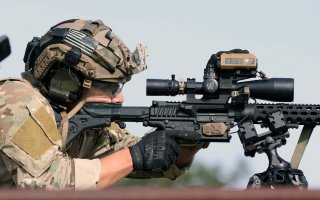Is Enough Priority Being Placed on Body Armor For Women?
Efforts to develop better-fitting body armor for women have been on the "to-do" list of the Pentagon for years, but little progress has been made, it seems.
There was some controversy earlier this year when it was announced that the United States Air Force would begin to produce maternity flight suits for female aviators, and more recently the U.S. Navy Reserve has followed suit with its own design for expectant mothers. While some have questioned whether there was an actual need for such flight suits, it should be noted that the clothing is worn by the aviators even when they're not on active flight duty.
"Pregnant aircrew who are not flying are still conducting squadron business," said Lt. Cmdr. Jacqueline Nordan, Commander, Naval Air Force Reserve's (CNAFR's) mobilization program manager last month. She suggested that wearing clothing that is clearly too large presents a less professional appearance for daily business.
"They're still instructing classes, working in simulators, giving briefings, and representing their organizations," added Nordan. It makes a big difference to be able to continue to represent ourselves professionally in a well-fitting uniform throughout a pregnancy."
The move forward with maternity flight suits also comes as lawmakers are now questioning why the U.S. Army left $81 million to "accelerate" body armor for women and short men out of its latest budget request. Efforts to develop better-fitting body armor for women have been on the "to-do" list of the Pentagon for years, but little progress has been made, it seems.
It was in December 2019 that U.S. Sen. Tammy Duckworth (D-Ill.), a combat veteran, was joined by Republican Senators Joni Ernst of Iowa and Martha McSally of Arizona, along with fellow Democrat Richard Blumenthal of Connecticut in introducing bipartisan legislation that would address ill-fitting body armor and personal protective equipment (PPE) across the military.
"When I was serving overseas, I experienced firsthand how our military's body armor and protective equipment hasn't always been constructed with the health and comfort of female service members in mind," Duckworth said in a statement at the time.
In 2004, while serving in Iraq as a U.S. Army helicopter pilot Duckworth suffered severe combat wounds after her aircraft was hit by a rocket-propelled grenade fired by Iraqi insurgents. She lost both of her legs and some mobility in her right arm. Despite her injuries, she sought and obtained a medical waiver that allowed her to continue to serve in the Illinois Army National Guard, and retired as a lieutenant colonel in 2014.
During her service in the Iraq War, Duckworth had found that small or extra small sizes of body armor – which fit women better but still not perfectly – were often in short supply.
"That's why I'm proud to be working on this important bipartisan bill that would enhance troop readiness by helping make sure our female servicemembers are properly equipped for combat," Duckworth added.
Fast forward to June 2021 and some progress has actually been made. It was last week that Department of Defense (DoD) leaders told Congress that they have designs and enough money to begin production, according to a report from DefenseOne. However, the Army has now requested an additional $81 million to accelerate the program and as a result, some lawmakers are questioning whether the DoD had actually given body armor and PPE the attention it required.
According to President Joe Biden's budget request, the Army included $155 million in fiscal year 2022 (FY22) for better fitting body armor as well as new extreme cold-weather gear – a response to Russia's renewed efforts to expand its sphere of influence in the region. However, the initial budget requests didn't actually list line items for body armor.
Progress has remained slow across the services for better fitting body armor, and it was only last year that the Air Force Life Cycle Management Center Female Fitment Program Office awarded its first contract to being production and development for body armor designed to better protect female Airmen during combat and contingency operations.
When the Army might also begin to introduce better fitting body armor for female warfighters seems to be a priority but not much of one. And until it is a serious priority, it could put those women at greater risk in combat zones around the world.
Peter Suciu is a Michigan-based writer who has contributed to more than four dozen magazines, newspapers, and websites. He regularly writes about military small arms and is the author of several books on military headgear including A Gallery of Military Headdress, which is available on Amazon.com.
Image: Reuters

